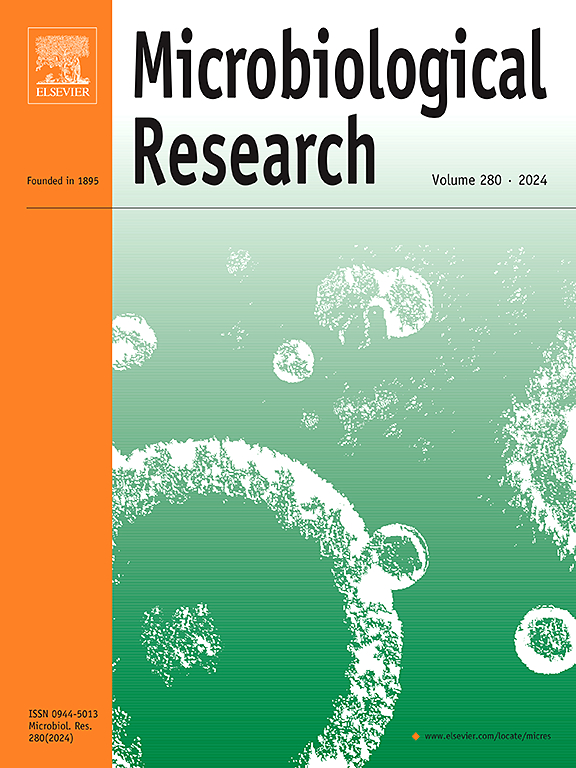双组分系统PvgAS协调毒力基因表达响应于蜂胶假单胞菌的渗透压
IF 6.9
1区 生物学
Q1 MICROBIOLOGY
引用次数: 0
摘要
假单胞菌是包括大黄鱼在内的多种鱼类的重要致病菌,造成严重的经济损失。VI型分泌系统(Type VI分泌system, T6SS)是其入侵和定植宿主所必需的,但在物理条件下调控毒力基因在体内表达的机制尚不清楚。在这项研究中,我们发现组氨酸激酶PvgS和反应调节剂PvgA组成同源双组分系统(TCS),该系统已被建立来调节包括T6SS-1在内的关键毒力基因的表达。染色质免疫沉淀测序(ChIP-seq)技术、qRT-PCR和电泳迁移转移测定(EMSA)揭示了ppleclossicida中PvgA直接控制的~ 106个基因中存在特异性PvgA结合标志。PvgS结合Na+和K+离子的结构模型和突变分析表明,PvgS介导了渗透压依赖性毒力基因T6SS-1和pvgAS的表达。PvgAS通过响应Na+、K+或Li+的不同渗透压来改变T6SS-1的表达,但不影响蔗糖的表达。此外,我们发现渗透压和温度在控制pleclossicida毒力基因表达的分层调控机制中具有不同的作用,即温度在低渗透环境下协同影响T6SS-1的分泌,而在高温和低温环境下渗透压都主导T6SS-1的表达。综上所述,我们的研究提供了PvgAS通过响应离子介导的渗透压变化介导pplecoglosiida毒力基因表达的新范式,并促进了对其体内和体外生活方式转换和细菌发病机制的理解。本文章由计算机程序翻译,如有差异,请以英文原文为准。
The two-component system PvgAS orchestrates virulence gene expression in response to osmolality in Pseudomonas plecoglossicida
Pseudomonas plecoglossicida is an important pathogen causing diseases in various fish including large yellow croaker leading to severe economic losses. Type VI secretion system (T6SS) has been established essential for its invasion and colonization in hosts, but the mechanism underlying regulation of virulence gene expression in vivo in physical conditions is still lacking. In this study, we identified that histidine kinase PvgS and response regulator PvgA consist a cognate two-component system (TCS) that has been established to regulate expression of key virulence genes including T6SS-1. Chromatin immuno-precipitation sequencing (ChIP-seq) technology, qRT-PCR and electrophoretic mobility shift assay (EMSA) revealed the specific PvgA binding Logos present in the ∼106 genes directly controlled by PvgA in P. plecoglossicida. Structural models of PvgS bound to Na+ and K+ ions and mutation analysis indicated that PvgS mediated an osmolality dependent virulence gene expression, i.e. T6SS-1 and pvgAS. PvgAS switch T6SS-1 expression by responding to different osmolality of Na+, K+, or Li+, but not sucrose. Moreover, we showed distinct roles of osmolality and temperature in the hierarchical regulatory mechanism to control the virulence gene expression in P. plecoglossicida, i.e. while temperature synergistically affects the T6SS-1 secretion at low osmotic environment, osmotic pressure dominates the expression of T6SS-1 at both high and low temperatures. Taken together, our study provided a new paradigm for PvgAS mediated virulence gene expression in P. plecoglossicida by responding to ion mediated osmolality variations, and facilitated the understanding of its in vivo and in vitro lifestyle switching and bacterial pathogenesis.
求助全文
通过发布文献求助,成功后即可免费获取论文全文。
去求助
来源期刊

Microbiological research
生物-微生物学
CiteScore
10.90
自引率
6.00%
发文量
249
审稿时长
29 days
期刊介绍:
Microbiological Research is devoted to publishing reports on prokaryotic and eukaryotic microorganisms such as yeasts, fungi, bacteria, archaea, and protozoa. Research on interactions between pathogenic microorganisms and their environment or hosts are also covered.
 求助内容:
求助内容: 应助结果提醒方式:
应助结果提醒方式:


